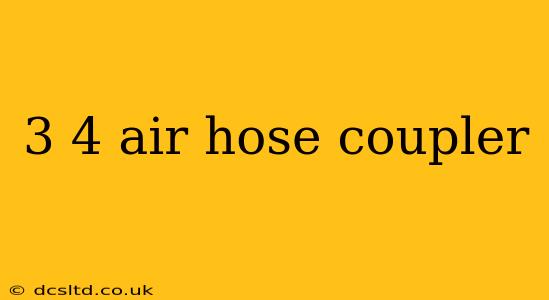Finding the right air hose coupler is crucial for efficient and safe compressed air applications. This guide dives deep into 3/4" air hose couplers, addressing common questions and providing valuable information for professionals and DIY enthusiasts alike. We'll cover different types, materials, applications, and considerations for selecting the perfect coupler for your needs.
What are the Different Types of 3/4" Air Hose Couplers?
3/4" air hose couplers come in various styles, each designed for specific purposes and preferences. The most common types include:
-
Push-to-Connect Couplers: These are incredibly easy to use; simply push the fitting onto the hose or tool until it clicks into place. They are ideal for quick connections and disconnections, making them popular in workshops and garages.
-
Threaded Couplers: These couplers use standard pipe threads for a secure and leak-free connection. They are generally more durable and suitable for high-pressure applications. They often require a wrench for tightening and loosening.
-
Quick-Connect Couplers (also known as "Plug-in" Couplers): These couplers feature a quick-release mechanism, offering speed and convenience while providing a secure seal. They are commonly used in industrial settings where time efficiency is paramount.
-
Swivel Couplers: These couplers allow for 360-degree rotation, preventing hose kinking and twisting. This is especially beneficial when using air tools in tight spaces or when the hose needs to be moved frequently.
What Materials are 3/4" Air Hose Couplers Made From?
The material of your coupler significantly impacts its durability and lifespan. Common materials include:
-
Brass: Known for its excellent corrosion resistance and durability, brass couplers are ideal for demanding applications and harsh environments.
-
Steel: Steel couplers offer superior strength and are suitable for high-pressure systems. They may require additional corrosion protection, such as plating or powder coating.
-
Aluminum: Aluminum couplers are lightweight and offer good corrosion resistance. They are a suitable option for applications where weight is a concern.
-
Plastic (Nylon, etc.): Plastic couplers are lightweight and cost-effective but are typically less durable and suitable only for lower-pressure applications.
What are 3/4" Air Hose Couplers Used For?
3/4" air hose couplers are used extensively across a wide array of applications, including:
-
Industrial Settings: Factories, manufacturing plants, and construction sites utilize these couplers for pneumatic tools, air compressors, and other compressed air systems.
-
Automotive Repair: Garages and automotive repair shops rely on these couplers for various tasks, including tire inflation, paint spraying, and the operation of pneumatic tools.
-
Agriculture: Air hose couplers are crucial for operating pneumatic equipment in agricultural settings.
-
DIY Projects: Homeowners and hobbyists use these couplers for inflating tires, using air tools, and other compressed air applications.
How Do I Choose the Right 3/4" Air Hose Coupler?
Selecting the right 3/4" air hose coupler depends on several factors:
-
Pressure Rating: Ensure the coupler's pressure rating exceeds the maximum operating pressure of your air compressor and tools.
-
Flow Rate: Consider the required air flow for your application to ensure the coupler can handle the volume.
-
Application: The specific application will dictate the type of coupler (push-to-connect, threaded, quick-connect, swivel) that's most suitable.
-
Material: Choose a material that's compatible with your environment and pressure requirements.
What is the Difference Between Male and Female 3/4" Air Hose Couplers?
Male and female couplers are designed to connect together. A male coupler has a protruding nipple or plug, while a female coupler has a recessed socket or receiving end. They are always used in pairs.
How Do I Maintain My 3/4" Air Hose Couplers?
Proper maintenance extends the lifespan of your air hose couplers. Regularly inspect for damage, leaks, and corrosion. Clean the couplers periodically to remove debris and prevent buildup. Replace any damaged or worn-out couplers promptly.
This comprehensive guide provides a solid understanding of 3/4" air hose couplers. Remember to always prioritize safety and select the coupler that best fits your specific application and requirements. Choosing the right coupler ensures efficient and safe operation of your compressed air system.
